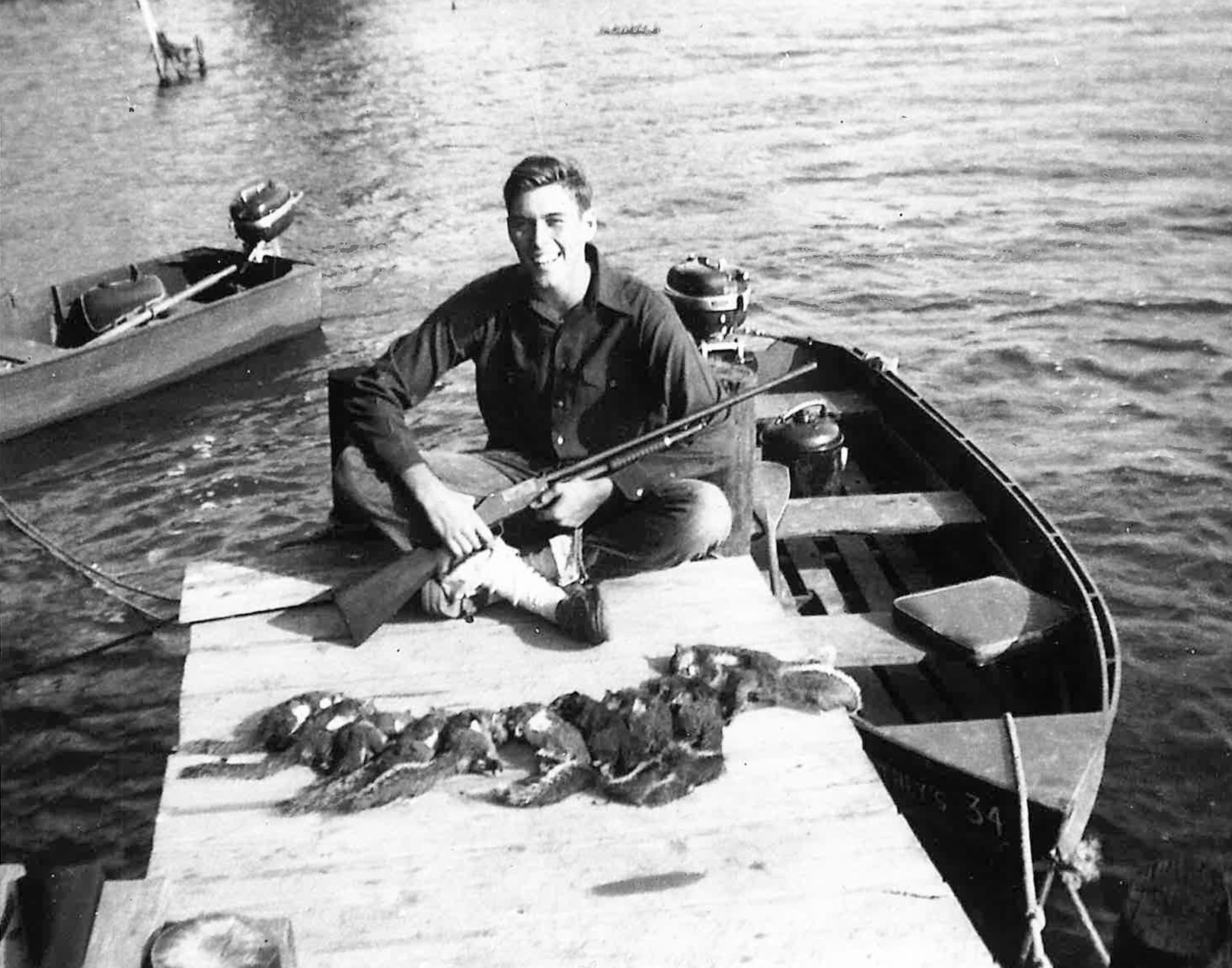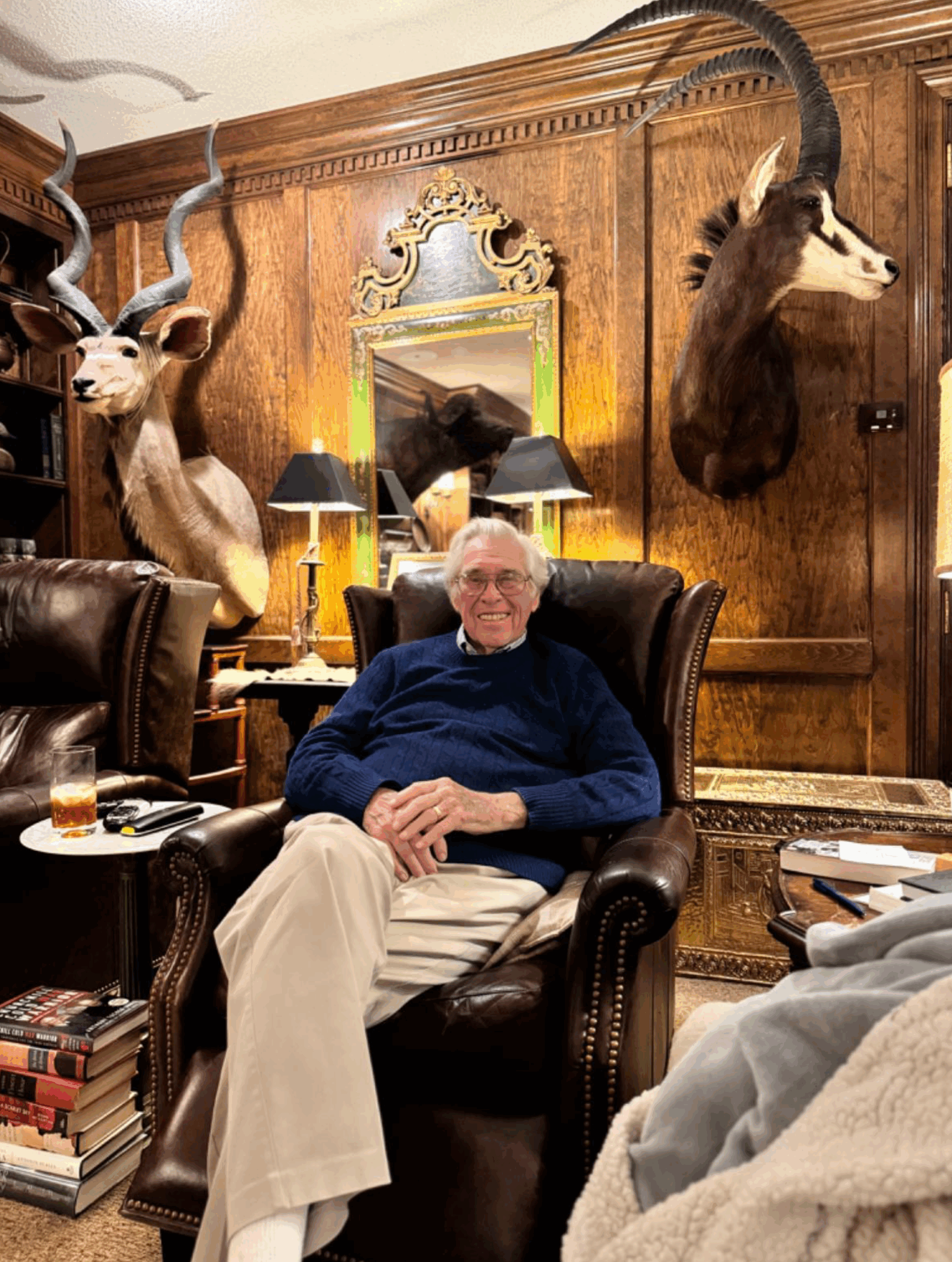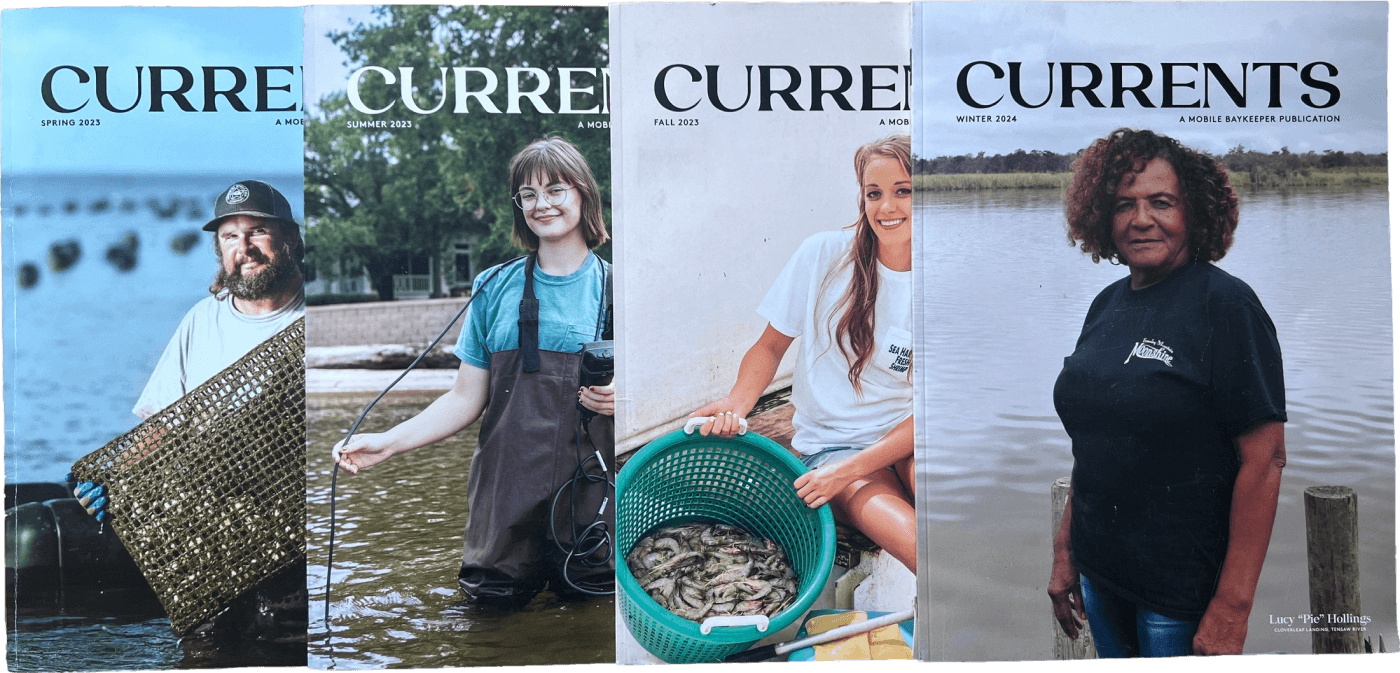
This article is from the summer 2025 edition of Mobile Baykeeper’s print quarterly, CURRENTS. The magazine is mailed to active members who have given more than $50 in the past year. To get on the magazine’s mailing list, donate here.
By Jody K. Harper
In a photograph from the late 1940s, a youthful hunter displays his take from the day, shotgun resting in his lap, two outboard skiffs floating in the water behind him. He is on a small dock festooned with the day’s harvest: squirrels, destined for a flavorful stew. Hand- some and pleased, he grins toward the camera lens. At age 93, Will Haas still greets the world with that same gracious smile, glimpsed in the photo taken at his uncle’s hunting camp so long ago. He has the same affable quality, a sign of his affirming, appreciative outlook on life.
Now retired from the marine supply business he operated in Mobile, Haas has nearly a century of connection to this area, its people, and its waterways. He has sailed the changing tides in life and business with a graceful ability to adapt to both loss and change. His love for the outdoors was cultivated by his uncle, Frank Venturini, and by the natural abundance of game available when he was young. Living was more closely entwined with nature then, both in hunting and raising animals and produce.
Born into an extended family, with deep roots in Alabama’s history, Haas is a descendant of German immigrants who accompanied Napoleonic French families to Alabama in the early 1800s. When his grandfather’s family moved south from Demopolis in 1835, they brought their wooden-pegged cottage downriver on a flatboat barge to Napoleonville, now the neighborhood of Crichton in Mobile. The homeplace still existed when Haas was growing up, situated near the pasture and stockyard.
Born in 1932, his childhood was buoyed by those who loved and cared for him. “I was the 11th of 11 children,” Haas says. “Papa had two sets of children — eight by his first wife, and then my brother Frank, my sister Betty, and me by our mother, his second wife.” Haas was only 18 months old when his mother, Beatrice Venturini Haas, was killed in a car accident in Catherine, Alabama. Though his father never spoke to the children of their mother, he donated a large stained-glass window to St. John’s Episcopal Church, as a memorial to honor her. “As a little boy, I would sit and look at that window, and think of her,” he says.
Looking through an album of family photos, he smiles at the image of a beautiful dark-haired girl holding him when he was a baby. “My sister Marguerite, she raised me, and so did Valley, she was our cook. She came to the house every day. She was wonderful.” Tending to their meals, readying them for school and awaiting their return, Valley served as a stand-in mother for the youngest Haas children. Summers and holidays were spent at his Papa’s summer house on Mon Louis Island near Fowl River. “We’d spend three to four weeks down there. We had a windmill to pump fresh water. The Creoles that lived behind us, the Collins family, had a garden, and they always had a sugarcane patch,” he recalls.
At 11 years old, he was sent off to Gulf Coast Military Academy in Biloxi, when his father married for a third time. After his father died in 1946, their mother’s brother raised Will and his brother on Alligator Creek near Dog River. When Haas mentions his uncle, Frank Venturini, he smiles with fondness and gratitude. Venturini became like a second father to him and his brother. “He was such a sweetheart and was so wonderful to us,” Haas says. “He adopted us.” Many of his happiest times were spent at his uncle’s home on Alligator Creek, and at their hunting camp in the Delta. “We built a camp on Raft River on a little ditch that goes from Raft River into the head of Grand Bayou — we could get to it with a skiff,” he says.
The Stauter family, known for their “Stauter-Built” boats, were their neighbors at the camp. “The Stauters lived about a quarter mile up from us on the Raft River — that was their old home place. When they came over here from Holland, they settled on Raft River. Jimmy Stauter would come by and have coffee with us. They were truck gardeners, and they would farm that marshland, raise vegetables, and take them down to Mobile on a skiff. They would tie up at the end of Eslava Street, and people would come down and buy their produce. We called them ‘bay gardeners’ — that’s an interesting name, isn’t it? It was tidewater here, and they were used to living on the water in Holland, so they knew how to deal with it, to plant their crops that way.”
Construction of the Causeway modernized transportation, but it blocked the flow of bays and rivers north of Mobile Bay, says Haas. “The Causeway changed everything – it dammed up the water. Now we don’t have the ducks here like we used to. When I was 14 or 15 years old, there must have been fifty-thousand ducks living in Chacaloochee and Mobile bays. They’d get up in the mornings and fly out. If it was real rough, they’d go up to Chuckfee and Grand Bay. And if it was real calm, they’d go out below the Causeway in Mobile Bay. You’d see them flying by the thousands in big flocks. In Chuckfee Bay and Grand Bay, that’s where we used to go duck hunting all the time. There were grey ducks, pintails, mallard, teal, canvasback. Green heads were the prize,” he says.
Duck camps were situated all along the Causeway at that time, and he recalls putting their boats in at Autrey’s Fishing Camp to go duck hunting. The health of grasses growing in the floor of the bays created habitat abundant with food for ducks and other marine life back then.
Growing up where he did, at the corner of Park Place and Springhill Avenue in Mobile, shaped his childhood insights. “One of the nice things about being born on Springhill Avenue was riding the streetcar to town. Valley would take me, and we’d go downtown. When I was about five or six years old, we’d take the streetcar and get off at Albright and Wood drugstore, right at Bienville Square.” In that time, air conditioning was a new addition to a few buildings, and unwelcome by this boy who had never experienced it. “The first time I ever went in there, I’d never been into an air-conditioned building before. As I walked in, it smelled terrible, because at that time, I don’t know what they used for refrigerant, but it had a horrible odor to it, and I screamed and hollered and I wouldn’t go in.”
One mentor to Haas was the young E.B. Sledge, whose family lived in the historic Creole cottage just west of their home. Sledge would later serve in the Marines during World War II on the South Pacific islands of Peleliu and Okinawa. He survived and went on to write an unflinching account of his experience in the book With the Old Breed. The book, which informed much of Ken Burns’ television series “The War,” described the savagery Sledge witnessed, as well as the bond of friendships built with fellow soldiers, including many of the battle-tested “old breed” who fought in earlier wars and pivotal battles.
Before the war, Sledge was a vibrant, enthusiastic individual who encouraged and inspired Haas. “He was interested in everything,” Haas says, from the far reaches of the world revealed in National Geographic articles, to his interest in antique muzzle-loaded guns, to making goat wagons, which in the time before the war was a fun type of transport for older boys. “He used to take me riding in his goat- drawn wagon,” Haas says. “He had one that was factory-made with painted scrolls on each side.”
Haas’s father’s family business, Haas-Davis Packing Company, opened in 1865 in the Southern Marketplace building on Royal Street, where the Mobile Museum of History is currently situated. Relocated to land in Prichard, this butchering plant was where Haas-Davis meats were manufactured, a staple in this area at that time. These days, people may give little thought to just how beef and pork is brought to their table, but when Haas was a boy, the slaughterhouse, or abattoir, as it was called, was part of that reality.
Butchering meat was a skill that had originated with the Haas ancestors, so it was a naturally chosen trade for the family. “I didn’t know anyone who didn’t have cows and hogs when I was growing up,” says Haas, whose family stockyard once lay on land near where Crichton Elementary was later established.
“They killed cattle on Mondays, Wednesdays, and Fridays at the packing plant, and they killed hogs on Tuesdays and Thursdays. You could always tell when they were killing hogs, because you could hear them from a mile away, squealing,” he recalls.
“The killing floor was up on the top floor of the building, and the second floor was the sausage room and smokehouse,” says Haas. “The bottom floor was where they salted the hams and bacon, putting them in these big oak barrels and they would fill it with water to brine. Next, they would put them in the smokehouse and smoke the meat with hickory logs.”
As a boy, Haas was also witness to one unusual hunt – the killing of lions at Grandview Park Zoo when the meat rationing took effect in 1942. “Grandview Park was on the south side of Dog River. It had all kind of animals in there, and was on the Bay. They had a big pier and pier house. People would go swimming and go to the zoo – it was a real popular place to go,” Haas explains. “When the war came, they couldn’t feed the lions, so they decided to kill them. Rationing was going on, so meat became real scarce. Mr. John Roth lived across the street from us on Park Avenue. He was a famous taxidermist, and he went down, and Papa sent a couple of skinners from the plant. We went down early one morning before daylight, my brother Frank and I, to watch, and they shot the two lions and they shot the cub and they hung them up between two trees and skinned them.”
From his boyhood perspective, Haas says, “It was exciting to see the lions, and watching them skinning them, that was interesting.” He was witness to the realities of wartime that drove the lion-keepers to dispose of animals rather than leave them to slowly starve from the lack of meat.
In later years, Haas traveled to Africa to hunt on safaris, a pastime informed by that early experience of the lions of Grandview Park. In his home, mounts of game animals, Lechwe, Impala, and more extend from the walls, a vivid tableau of African wildlife on display. As an adult, Haas served in the Navy in 1952, during the Korean War, returning to Mobile and later earning his law degree from University of Alabama in 1958. He practiced law for a short time, but changed careers when, in 1961, he married Ann Hall Haas, and they moved forward with the continuation of a marine surplus business, naming their venture Southern Marine Supply, Inc.
Together they worked on sourcing and selling rigging equipment for cargo ships, buying and selling wire rope, block, and turnbuckles. Their company also fabricated huge wire rope-slings for use on ships. They worked well as a team. The business, housed on Commerce Street next to the Mobile Ship Chandlery, was eventually relocated to Brookley Field.
“Originally, we were selling to ship’s agents, replacing parts needed for the rigging,” Haas says. This was at a time when stevedores planned the placement of cargo and longshoremen did the actual loading and unloading of ships. An aerial photo from the early 1950s that had hung in the office of his uncle, George A. Haas, who was then vice president of Merchant’s National Bank, shows these old ships, their decks replete with rigging gear.
His nephew, Russell Haas, says his uncle Will was well suited for the supply business. “Will had the natural personality that was perfect for relating to his clients and those in the shipping world. He is very well-read, and well-traveled, intuitive, and his outdoor upbringing held him in good stead with these businessmen who found him honest, hardworking, and smart. A lot of people gravitate to him, the depth and the breadth of the person he is comes through.”
Early in his business life, he found inventory sourced from the wrecking yards in Panama City, Florida, when the Liberty ships were broken down for scrap and various parts were available for sale.
When Malcolm McLean invented standardized metal container shipping and began re-fitting traditional cargo ships in Mobile in 1956, after buying Waterman Steamship Company, the entire market was altered. Traditional merchant steamships were defrocked of their blocks, shackles, turnbuckles, and wire cables, the components that Haas’s company had sold for the job of moving cargo. “Malcolm changed the world, no question about that — he was a real innovator,” he admits. But the change destroyed the jobs of longshoremen and demand for his inventory.
Haas found a new avenue for business when the boom in the building of new shrimp boats took hold. He said when he was a boy, shrimp were only harvested in Mobile Bay, but the chance discovery that brown shrimp came up into the Gulf waters at night gave harvesters a whole new territory to cover. Their boats needed heavy wire rope-slings, block, and all the equipment for setting and hauling deep-water nets. “They were building shrimp boats in Bayou La Batre, Ocean Springs, Pensacola, and Apalachicola,” he notes. His work took him to overseas sources, finding great workmanship and better pricing from vendors in Korea, after earlier sourcing from Germany and Japan.
His successes led him to enjoy sporting adventures, both on his fishing yacht, the “Sling Queen,” and having a business endeavor in the shrimping industry with the “Anna Riley,” a boat named for his wife. His first wife died in 2009, and she is remembered as a successful businesswoman who enjoyed the partnership of work and the extensive travel they enjoyed together.
After years as a widower, Haas remarried Darlene Haas, and they have enjoyed a happy marriage living in the family home in Fairhope. Looking back, his days with family, and his many exploits in work and in the outdoors, still bring a smile to his face.

